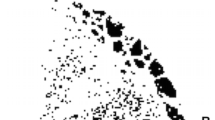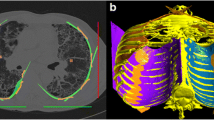Abstract
Objectives
To evaluate the usefulness of a texture-based automated quantification system (AQS) for evaluating the extent and interval change of regional disease patterns on initial and follow-up high-resolution computed tomographies (HRCTs) of fibrotic interstitial pneumonia (FIP).
Methods
Eighty-nine patients with clinically and/or biopsy confirmed usual interstitial pneumonia (UIP) (n = 71) and non-specific interstitial pneumonia (NSIP) (n = 18) were included. An AQS to quantify five disease patterns (ground-glass opacity [GGO], reticular opacity [RO], honeycombing [HC], emphysema [EMPH], consolidation [CONS]) and normal lung was developed. The extent and interval changes of each disease pattern, FS (fibrosis score), TA (total abnormal lung fraction) of entire lung on initial and 1-year follow-up HRCTs were quantified. The agreement between the results of AQS and two readers was assessed. Results of AQS were correlated with forced vital capacity (FVC) and carbon monoxide diffusing capacity (DLco).
Results
The Intraclass correlation coefficient (ICC) study revealed acceptable agreement between visual assessment and AQS (r = 0.78, 0.66 for HC; 0.76, 0.61 for FS; 0.64, 0.68 for TA, initial and follow-up HRCTs, respectively). Linear regression analysis revealed the extent of HC, TA on initial CT, interval changes of FS contributed negatively to DLco, and interval changes of FS, TA contributed negatively to FVC.
Conclusions
Our AQS is comparable with visual assessment for evaluating the disease extent and the interval changes of FIP on HRCT.
Key Points
• HRCT is widely used to assess fibrotic interstitial pneumonia
• An automated quantification system matched well with visual assessment of HRCT
• Abnormal lung fraction on HRCT correlated with the decrease in diffusion capacity
• Automated quantification of HRCT images is useful in assessing fibrotic interstitial pneumonia



Similar content being viewed by others
Abbreviations
- HRCT:
-
High-resolution computed tomography
- DILD:
-
Diffuse interstitial lung disease
- FIP:
-
Fibrotic interstitial pneumonia
- AQS:
-
Automated quantification system
- IPF:
-
Idiopathic pulmonary fibrosis
- NSIP:
-
Non-specific interstitial pneumonia
- UIP:
-
Usual interstitial pneumonia
- PFT:
-
Pulmonary function test
- GGO:
-
Ground-glass opacity
- RO:
-
Reticular opacity
- HC:
-
Honeycombing
- EMPH:
-
Emphysema
- CONS:
-
Consolidation
- NL:
-
Normal lung
- FS:
-
Fibrosis score
- TA:
-
Total abnormal lung fraction
- FVC:
-
Forced vital capacity
- DLco:
-
Carbon monoxide diffusing capacity
References
Muller NL (1991) Clinical value of high-resolution CT in chronic diffuse lung disease. AJR Am J Roentgenol 157:1163–1170
Nishimura K, Izumi T, Kitaichi M, Nagai S, Itoh H (1993) The diagnostic accuracy of high-resolution computed tomography in diffuse infiltrative lung diseases. Chest 104:1149–1155
Scatarige JC, Diette GB, Haponik EF, Merriman B, Fishman EK (2003) Utility of high-resolution CT for management of diffuse lung disease: results of a survey of U.S. pulmonary physicians. Acad Radiol 10:167–175
Gay SE, Kazerooni EA, Toews GB, Lynch JP 3rd, Gross BH, Cascade PN et al (1998) Idiopathic pulmonary fibrosis: predicting response to therapy and survival. Am J Respir Crit Care Med 157:1063–1072
Park YS, Seo JB, Kim N et al (2008) Texture-based quantification of pulmonary emphysema on high-resolution computed tomography: comparison with density-based quantification and correlation with pulmonary function test. Investig Radiol 43:395–402
Padley SP, Hansell DM, Flower CD, Jennings P (1991) Comparative accuracy of high resolution computed tomography and chest radiography in the diagnosis of chronic diffuse infiltrative lung disease. Clin Radiol 44:222–226
Best AC, Lynch AM, Bozic CM, Miller D, Grunwald GK, Lynch DA (2003) Quantitative CT indexes in idiopathic pulmonary fibrosis: relationship with physiologic impairment. Radiology 228:407–414
Best AC, Meng J, Lynch AM et al (2008) Idiopathic pulmonary fibrosis: physiologic tests, quantitative CT indexes, and CT visual scores as predictors of mortality. Radiology 246:935–940
Castellano G, Bonilha L, Li LM, Cendes F (2004) Texture analysis of medical images. Clin Radiol 59:1061–1069
Delorme S, Keller-Reichenbecher MA, Zuna I, Schlegel W, Van Kaick G (1997) Usual interstitial pneumonia. Quantitative assessment of high-resolution computed tomography findings by computer-assisted texture-based image analysis. Investig Radiol 32:566–574
Rodriguez LH, Vargas PF, Raff U et al (1995) Automated discrimination and quantification of idiopathic pulmonary fibrosis from normal lung parenchyma using generalized fractal dimensions in high-resolution computed tomography images. Acad Radiol 2:10–18
Zavaletta VA, Bartholmai BJ, Robb RA (2007) High resolution multidetector CT-aided tissue analysis and quantification of lung fibrosis. Acad Radiol 14:772–787
Park SO, Seo JB, Kim N et al (2009) Feasibility of automated quantification of regional disease patterns depicted on high-resolution computed tomography in patients with various diffuse lung diseases. Korean J Radiol 10:455–463
Park SO, Seo JB, Kim N, Lee YK, Lee J, Kim DS (2011) Comparison of usual interstitial pneumonia and nonspecific interstitial pneumonia: quantification of disease severity and discrimination between two diseases on HRCT using a texture-based automated system. Korean J Radiol 12:297–307
Raghu G, Collard HR, Egan JJ et al (2011) An official ATS/ERS/JRS/ALAT statement: idiopathic pulmonary fibrosis: evidence-based guidelines for diagnosis and management. Am J Respir Crit Care Med 183:788–824
Uppaluri R, Hoffman EA, Sonka M, Hunninghake GW, McLennan G (1999) Interstitial lung disease: a quantitative study using the adaptive multiple feature method. Am J Respir Crit Care Med 159:519–525
Xu Y, van Beek EJ, Hwanjo Y, Guo J, McLennan G, Hoffman EA (2006) Computer-aided classification of interstitial lung diseases via MDCT: 3D adaptive multiple feature method (3D AMFM). Acad Radiol 13:969–978
American Thoracic Society (1995) Standardization of spirometry, 1994 update. Am J Respir Crit Care Med 152:1107–1136
American Thoracic Society (1995) Single-breath carbon monoxide diffusing capacity (transfer factor). Recommendations for a standard technique—1995 update. Am J Respir Crit Care Med 152:2185–2198
Kim N, Seo JB, Lee Y, Lee JG, Kim SS, Kang SH (2009) Development of an automatic classification system for differentiation of obstructive lung disease using HRCT. J Digit Imaging 22:136–148
Lee Y, Seo JB, Lee JG, Kim SS, Kim N, Kang SH (2009) Performance testing of several classifiers for differentiating obstructive lung diseases based on texture analysis at high-resolution computerized tomography (HRCT). Comput Methods Programs Biomed 93:206–215
Silva CI, Müller NL, Hansell DM, Lee KS, Nicholson AG, Wells AU (2008) Nonspecific interstitial pneumonia and idiopathic pulmonary fibrosis: changes in pattern and distribution of disease over time. Radiology 247:251–259
Edey AJ, Devaraj AA, Barker RP, Nicholson AG, Wells AU, Hansell DM (2011) Fibrotic idiopathic interstitial pneumonias: HRCT findings that predict mortality. Eur Radiol 21:1586–1593
Shin KE, Chung MJ, Jung MP, Choe BK, Lee KS (2011) Quantitative computed tomographic indexes in diffuse interstitial lung disease: correlation with physiologic tests and computed tomography visual scores. J Comput Assist Tomogr 35:266–271
Johkoh T, Müller NL, Colby TV et al (2002) Nonspecific interstitial pneumonia: correlation between thin-section CT findings and pathologic subgroups in 55 patients. Radiology 225:199–204
Sumikawa H, Johkoh T, Ichikado K et al (2006) Usual interstitial pneumonia and chronic idiopathic interstitial pneumonia: analysis of CT appearance in 92 patients. Radiology 241:258–266
Arakawa H, Yamada H, Kurihara Y et al (2003) Nonspecific interstitial pneumonia associated with polymyositis and dermatomyositis: serial high-resolution CT findings and functional correlation. Chest 123:1096–1103
Author information
Authors and Affiliations
Corresponding author
Rights and permissions
About this article
Cite this article
Yoon, R.G., Seo, J.B., Kim, N. et al. Quantitative assessment of change in regional disease patterns on serial HRCT of fibrotic interstitial pneumonia with texture-based automated quantification system. Eur Radiol 23, 692–701 (2013). https://doi.org/10.1007/s00330-012-2634-8
Received:
Revised:
Accepted:
Published:
Issue Date:
DOI: https://doi.org/10.1007/s00330-012-2634-8




